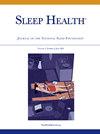Insufficient sleep in the Danish adult population: A 10-year trend analysis
IF 3.4
2区 医学
Q2 CLINICAL NEUROLOGY
引用次数: 0
Abstract
Objectives
To examine (1) trends in insufficient sleep among adults in Denmark from 2013 to 2023; (2) sociodemographic characteristics associated with insufficient sleep; and (3) self-reported reasons for insufficient sleep.
Methods
Data were derived from the nationally representative Danish Health and Morbidity Surveys conducted in 2013, 2017, 2021, and 2023. In each wave 25,000 individuals aged 16 years or older were invited to participate (response proportions: 40%-60%). Insufficient sleep was measured as never or almost never getting enough sleep to feel well-rested.
Results
The proportions reporting insufficient sleep increased from 10.3% in 2013 to 15.9% in 2023. Consistently, a higher proportion was observed among women, and among the younger age groups (age 16-44 years). A clear social gradient was observed, with higher odds of insufficient sleep among those with <10 years education (OR 2.13, 95% CI: 1.91; 2.37) compared to those with ≥15 years of education. Self-reported reasons for insufficient sleep varied slightly across survey waves. In 2023, primary reasons included thoughts and worries related to family or personal matters (44.4%) and getting to bed too late due to entertainment from digital devices (35.5%). However, the specific reasons varied by sex and age groups.
Conclusions
The proportion of adults reporting insufficient sleep has increased substantially over the past decade. Clear and consistent sex and age differences, as well as social inequalities in insufficient sleep in all waves indicate the need for targeted initiatives promoting sleep health.
丹麦成年人睡眠不足:10年趋势分析
目的:研究(1)2013 - 2023年丹麦成年人睡眠不足趋势;(2)与睡眠不足相关的社会人口学特征;(3)自我报告睡眠不足的原因。方法:数据来源于2013年、2017年、2021年和2023年进行的具有全国代表性的丹麦健康和发病率调查。在每一波中,25,000名年龄在16岁或以上的人被邀请参加(回应比例:40%-60%)。睡眠不足指的是从未或几乎从未有足够的睡眠来让自己得到充分的休息。结果:报告睡眠不足的比例从2013年的10.3%上升到2023年的15.9%。一直以来,在女性和较年轻的年龄组(16-44岁)中观察到较高的比例。结论:在过去十年中,报告睡眠不足的成年人比例大幅增加。性别和年龄的明显和一致的差异,以及在所有波睡眠不足的社会不平等表明需要有针对性的倡议,促进睡眠健康。
本文章由计算机程序翻译,如有差异,请以英文原文为准。
求助全文
约1分钟内获得全文
求助全文
来源期刊

Sleep Health
CLINICAL NEUROLOGY-
CiteScore
6.30
自引率
9.80%
发文量
114
审稿时长
54 days
期刊介绍:
Sleep Health Journal of the National Sleep Foundation is a multidisciplinary journal that explores sleep''s role in population health and elucidates the social science perspective on sleep and health. Aligned with the National Sleep Foundation''s global authoritative, evidence-based voice for sleep health, the journal serves as the foremost publication for manuscripts that advance the sleep health of all members of society.The scope of the journal extends across diverse sleep-related fields, including anthropology, education, health services research, human development, international health, law, mental health, nursing, nutrition, psychology, public health, public policy, fatigue management, transportation, social work, and sociology. The journal welcomes original research articles, review articles, brief reports, special articles, letters to the editor, editorials, and commentaries.
 求助内容:
求助内容: 应助结果提醒方式:
应助结果提醒方式:


